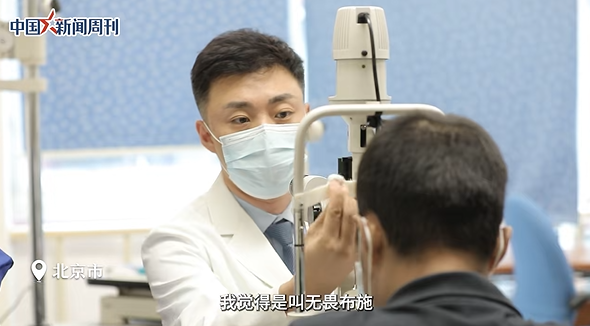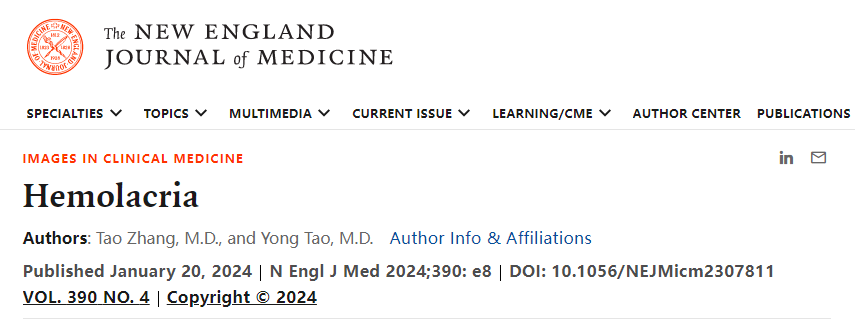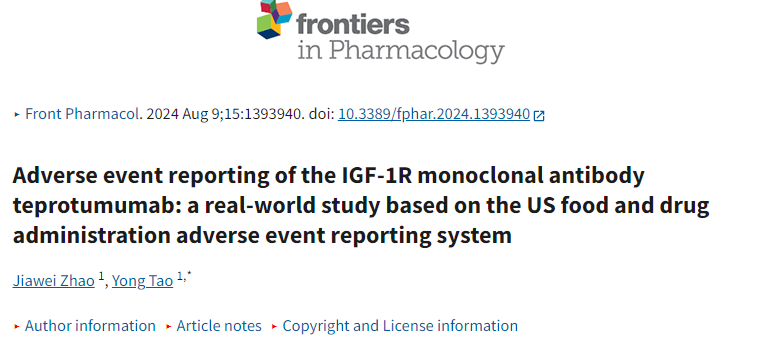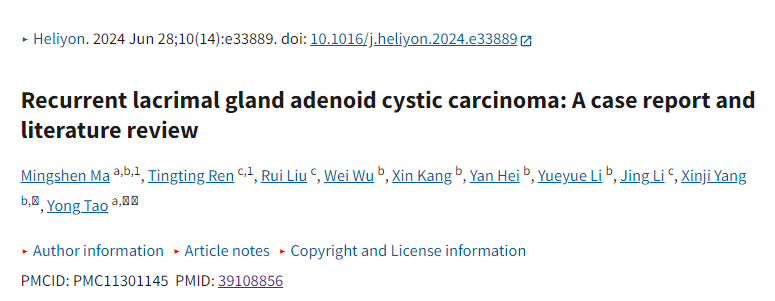
In January 2020, Dr. Tao Yong was violently attacked during a visit to
Chaoyang Hospital in Beijing, resulting in a serious injury to his left hand and
even having to temporarily leave the clinical front line.
However, over the years, Dr. Tao Yong has been tirelessly working on the
front line of scientific research, demonstrating with practical actions what
true medical compassion truly means.
Whether on the operating table or in the laboratory, he constantly explores
new fields of ophthalmic medicine with unparalleled passion and professionalism,
committed to bringing more hope and light to patients.

In 2024, Dr. Tao Yong's research journey can be described as fruitful, with
more than ten SCI papers successfully published online. We have selected some
articles for display, let's take a look together ↓↓↓
The first NEJM (IF=96.2)
On January 20, 2024, Dr. Tao Yong and Dr. Zhang Tao from Beijing Chaoyang
Hospital affiliated with Capital Medical University jointly published a case
report titled "Hemolacria" in The New England Journal of Medicine.
This case report provides a detailed record of the clinical symptoms of a
rare blood tear syndrome, systematically describing its pathogenesis, clinical
characteristics, and diagnostic and treatment methods. This case provides
valuable diagnostic insights for ophthalmologists and emergency department
doctors, and suggests that when encountering similar patients, the possibility
of blood reflux to the lacrimal system after nosebleeds treatment should be
considered.

The second article is Adv. Healthcare Mater (IF=10)
On October 23, 2024, Dr. Tao Yong's team published an article titled "In
Situ Crystallized Ceria Vesicle Nanohybrid Therapy for Effective Treatment of
Inflammatory Intraocular Disease".
Posterior uveitis can lead to severe visual impairment, with oxidative
stress exacerbating inflammation and forming a continuous cycle of damage, which
current treatments can only temporarily alleviate. This study developed a novel
treatment method, which involves in situ crystallization of ultra small cerium
oxide nanoparticles (approximately 3 nanometers) on extracellular vesicles (EVs)
of mesenchymal stem cells (MSCs) for the treatment of sensitized mycobacterial
uveitis (PMU). This nanocomposite material utilizes the independent and
synergistic effects of its components to provide a comprehensive treatment
plan.

Chapter 3: J.Infect. Dis. (IF=5)
On January 12, 2024, Dr. Tao Yong's team published an article titled
"Performance of Metagenomic Next Generation Sequestration of Cell Free DNA from
Vitreous and Aquatic Humor for Diagnoses of Intraocular Infections".

Delayed diagnosis and inappropriate treatment of intraocular infections
often lead to poor prognosis. Due to the limitations of traditional cultivation
and PCR methods, most pathogens cannot be identified. This study demonstrates
the potential of using metagenomic next-generation sequencing (mNGS) technology
for rapid and accurate diagnosis of suspected intraocular infection patients.
Through analysis of cell-free DNA in vitreous and aqueous humor samples from 488
patients, it was found that mNGS not only improves the sensitivity and accuracy
of pathogen identification compared to traditional diagnostic methods, but is
also particularly suitable for small volume samples. Moreover, mNGS using
vitreous humor samples showed slightly better sensitivity and diagnostic
accuracy than aqueous humor samples, providing new directions and technical
support for the diagnosis of intraocular infections in the future.
The Fourth Frontier Pharmacol.(IF=4.4)
On August 9, 2024, Dr. Tao Yong's team published an article titled "Adverse
event reporting of the IGF-1R monoclonal antibody tepotumumab: a real-world
study based on the US food and drug administration adverse event reporting
system".

This study conducted a detailed exploration of adverse events that occurred
during the treatment of thyroid eye disease with trastuzumab by analyzing data
from the FDA's adverse event reporting system. Research has found that the use
of trastuzumab may lead to various adverse events, particularly musculoskeletal
problems, fatigue, tinnitus, and most reports come from female patients. These
findings provide important information for the safer use of trastuzumab in
clinical practice, and also contribute to the further development of the drug
and its promotion in the global market.
Chapter 5: Heliyon (IF=3.4)
On June 28, 2024, Dr. Tao Yong's team published a case report titled
"Recurrent lacrimal glass adenoid cystic carcinoma: A case report and literature
review" in Heliyon.
Adenoid cystic carcinoma of the lacrimal gland (LGACC) is known for its
high recurrence rate, tendency towards nerve invasion, and distant metastasis,
leading to poor prognosis for patients. This case report provides a detailed
description of the diagnosis and treatment of the disease.
In the case, a 34 year old male patient presented with persistent symptoms
of left eye protrusion for 4 months. After imaging examination, it was highly
suspected to be LGACC, and the diagnosis was confirmed through eye conserving
orbital tumor resection surgery. Although postoperative radiation therapy was
recommended, the patient refused to accept it, resulting in tumor recurrence
within 3 months after surgery. Eventually, more aggressive orbital contents
removal surgery had to be performed, and pathological results showed poorly
differentiated LGACC. Subsequently, the patient followed the doctor's advice and
received radiation therapy, but within less than a year, intracranial metastasis
occurred.

This case highlights the difficulty in early diagnosis of LGACC due to its
insidious onset and lack of specific symptoms, as well as its tendency to recur
and metastasize. It emphasizes the need for early diagnosis, active treatment
strategies, and strict adherence to postoperative adjuvant therapy to improve
patient prognosis. Future research should focus on a deeper understanding of the
pathogenesis of LGACC and strive to develop standardized diagnosis and treatment
plans to improve patients' survival rates and quality of life.
Other articles:
1.Li, P., Z. Qian and Y. Tao, Application of metagenomic next-generation sequencing in the diagnosis of Bartonella neuroretinitis: a case report and literature review. J Ophthalmic Inflamm Infect, 2024. 14(1): p. 17.
2.Ma, M., et al., Recurrent lacrimal gland adenoid